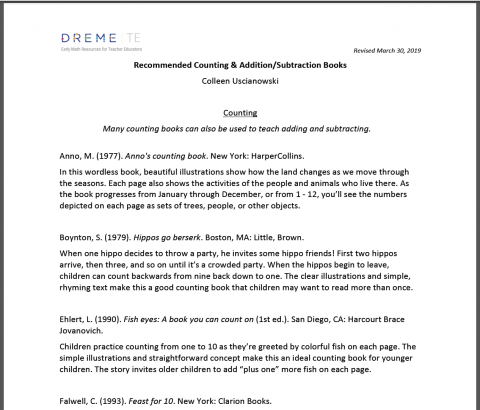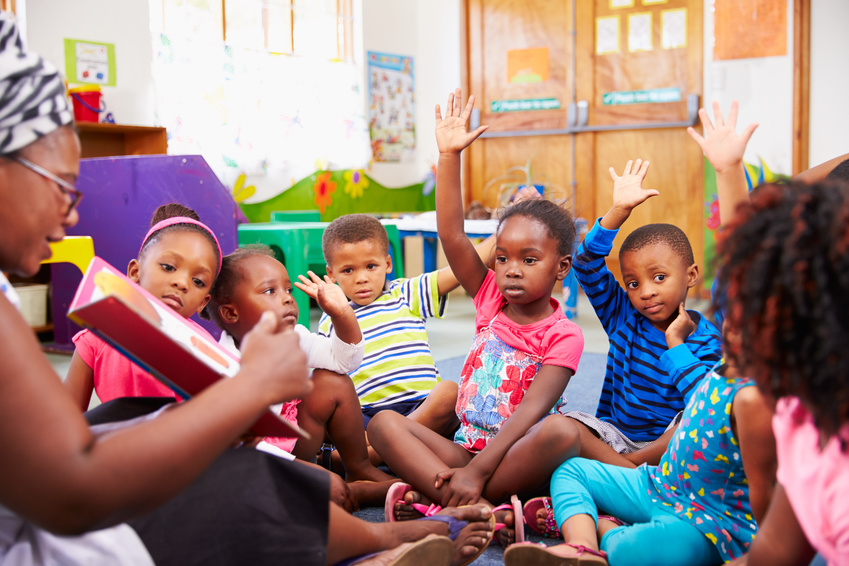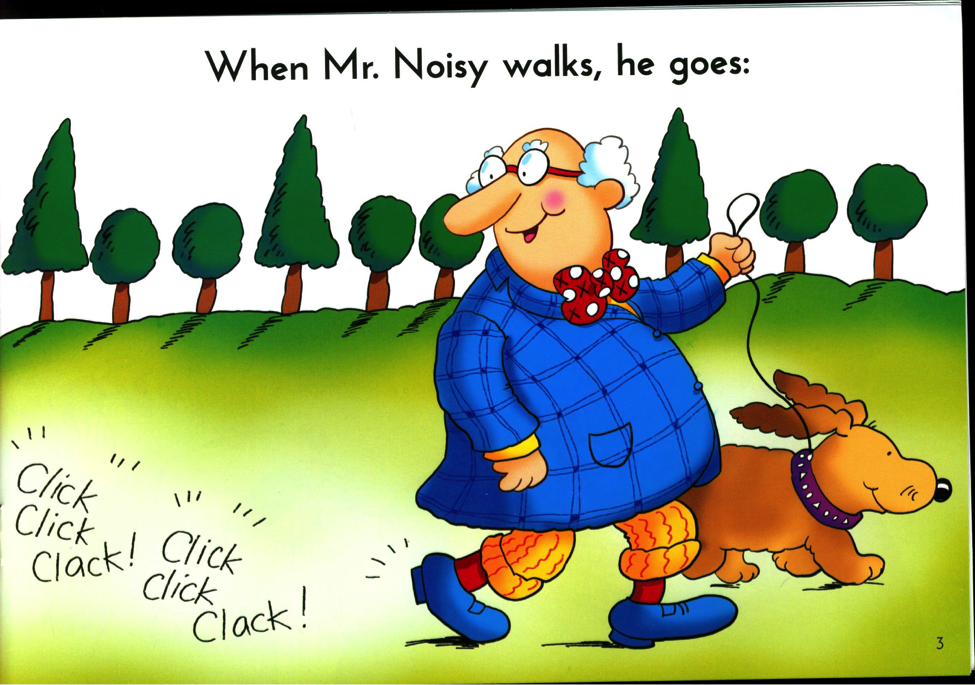Imagine that you, as a teacher, are preparing to read a book to a child or group of children and you want to use the story as an opportunity to develop understanding of addition and subtraction. This document describes how you might proceed.
Revised March 30, 2019
Recommended Addition and Subtraction Picture Books

Supporting Engagement with Addition and Subtraction Books
Preparing to Read
You can use Analyzing Picture Books—An Overview with its downloadable Math Picture Book Analysis Guide to help you examine and select one or more addition and subtraction books. Review How to Use Picture Books for some general tips for how to plan to read books with children.
Consider a specific example. These pages are from Rooster’s Off to See the World by Eric Carle, a book about a rooster who meets many friends on his journey. On this two-page spread, one rooster, two cats, and three frogs are joined by four turtles.
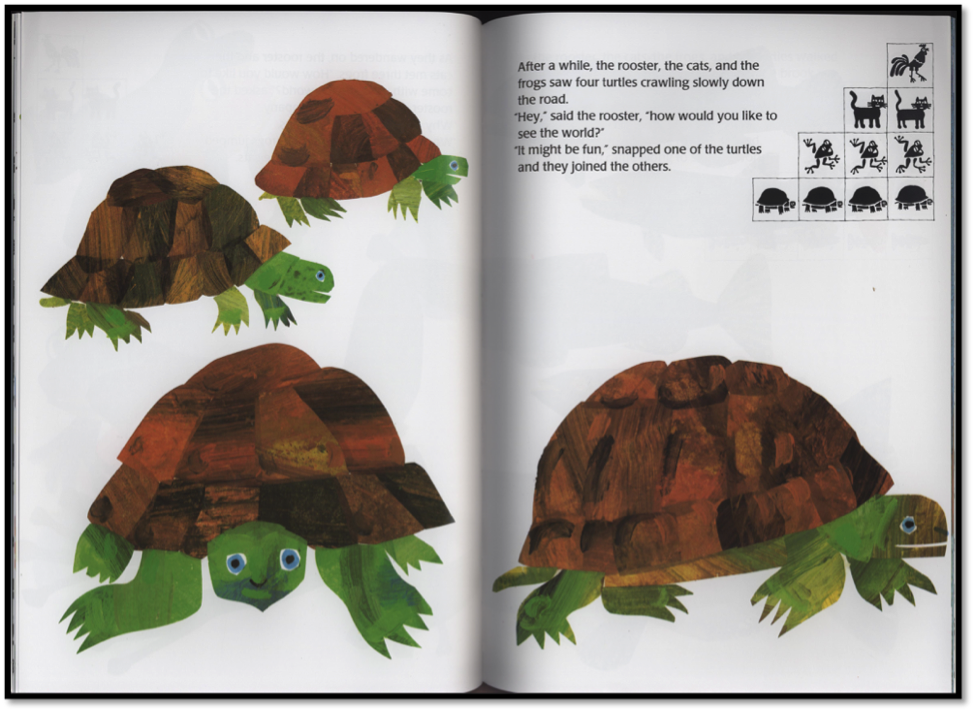
Try to look through the book from a child’s perspective. For example, on the page above, we see symbols—schematic pictures—in the squares drawn on the upper right side of the page. These symbols represent the rooster, cats, frogs, and turtles that have embarked on the journey so far. The symbols are shown, from top to bottom, in order of the appearance and number of animals. However, young children often have difficulty with interpreting symbols and therefore may not understand how they connect with the animals they’ve met in the story. If asked to count the total number of animals, they may not realize that they can use these symbols to help them add the one rooster, two cats, three frogs, and four turtles. Instead, they may, for example, count eight turtles on the page (four large illustrations and four schematic symbols).
During Reading
Ask questions.
As appropriate, ask a variety of question types, both lower-level and higher-level.
- Lower-level questions are relatively simple and concrete, addressing what children see directly on the page as well as key words from the text that you think they might not understand. For example:
- Recall: What animals has the rooster met so far? What did the rooster ask the animals?
- Label: What is this animal called?
- Describe: How many turtles do you see? How were the turtles crawling down the road?
- Higher-level questions are relatively complex and abstract, asking children to engage in deep thinking and go beyond the literal events on the page. For example:
- Predict: What do you think will happen next in the story?
- Infer: Why do you think the turtles agreed to join the other animals to see the world?
- Make judgments: Do you think it was a good idea or a bad idea for all the animals to join rooster on his adventure?
Explore children's responses.
Elaborate on children’s responses and ask follow-up questions. For example:
- Teacher: What is this animal called?
- Child: A turtle.
- Teacher: That’s right, a turtle. Its shell protects the turtle. Can you think of another animal that has a shell or protects itself some other way?
Follow up with open-ended questions asking children to explain their reasoning. For example:
- Teacher: So far the rooster met two cats, three frogs, and four turtles. What do you think will happen next in the story?
- Child: I think they’ll meet five more animals!
- Teacher: Why do you think they’ll meet five more animals? What animal might they meet next?
Model complex thinking.
One way children learn is by listening to you, the adult, model productive ways of thinking about the story. For example:
- Teacher: I notice that the rooster always asks the other animals to join him on his adventure to see the world. That makes me think the rooster is friendly and likes the company of his animal friends. What do you think?
More Examples for Addition and Subtraction Books
Below are suggestions for how you can use picture books that lend themselves to addition and subtraction as part of classroom instruction. While reading and discussing a storybook about addition and/or subtraction, children can learn and demonstrate their understanding of many different kinds of number concepts. Here are some examples.
What Children Can Learn
Using the book shown above, Rooster’s Off to See the World , a teacher can focus on a variety of number concepts. For example, you can ask children to solve oral word problems involving adding or subtracting one, which builds on the child’s understanding of the counting numbers. For example,
- Rooster is joined by two cats. If one more cat joins them, how many cats will there be?
- There are four turtles. If one turtle leaves, how many will be left?
Oral word problems or situations with totals less than or equal to 10. For example:
- Rooster is joined by his friends, the two cats. How many animals are there now?
- There are ten animals. If the four turtles leave, how many animals will be left?
Problems that involve putting together and taking apart small quantities. For example:
- I see four turtles. These two turtles and these two make four.
Young children may benefit from using their fingers to help them add and subtract. When calculating how many animals there are when rooster is joined by the two cats, they can hold up one finger for the rooster and two for the cats, then count up all the fingers to find the sum of three. Young children also benefit from acting out addition and subtraction scenarios or using physical materials, such as counters or bears, to help them when they are learning how to add and subtract.
Questioning the Child
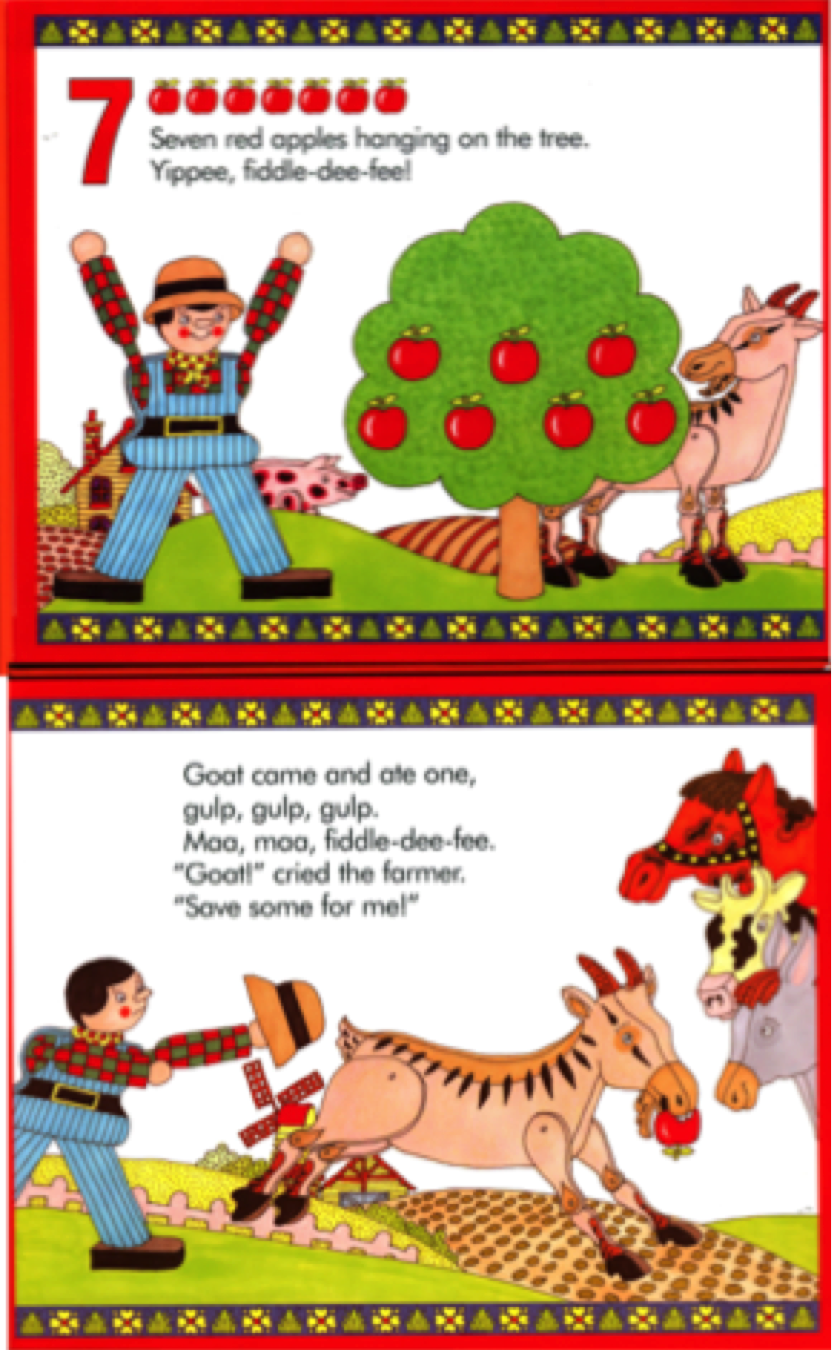
Regardless of the content, teachers should ask both concrete and abstract questions as appropriate. The picture book, Ten Red Apples by Pat Hutchins, is another book that can be used to teach operations.
Lower-level Questions
Ask children to describe the scene to find out how many relevant words they use spontaneously.
- What’s happening on this page?
Ask children to name the number of objects in the illustration.
- How many apples are on the tree?
- Can you count the number of animals?
Ask children to locate and count the seven apples.
- I see seven apples. Can you point to the seven apples?
If the children struggle to correctly count the apples, you can provide guidance by counting along with them.
- Let’s try again. Count with me as I point to each apple: one, two, three, four, five, six, seven. There are seven apples!
Higher-level Questions
Ask children to make a prediction about what will happen if you subtract.
- Oh no, Goat just ate one apple! There were seven apples. How many are left?
- If Farmer loses another apple, how many will be left then?
Ask children to make a prediction about what will happen if you add.
- Farmer has seven apples. What if he found another tree with two apples? How many apples would Farmer have altogether?
Ask children to put together or take apart the number of apples.
- Farmer has seven apples. How many are on the bottom row? How many are on the top row?
- Four and three make seven. Can you think of another way to make seven?
Ask children to make an inference about numbers.
- Goat has an apple. If each of his animal friends wants an apple too, how many more apples will Goat need?
You can respond to children’s answers to any of these questions by asking:
- How did you know?
- Why did you say that?
- Why did you predict that?

